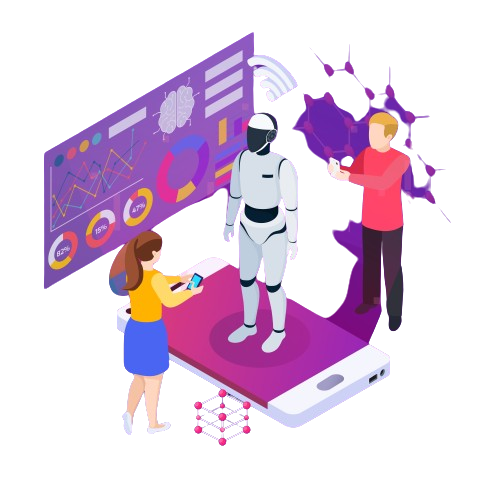
In the fast-paced landscape of cutting-edge commercial enterprise, where the intersection of era and customer expectations defines success, Artificial Intelligence (AI) stands as a transformative pressure, reshaping the very essence of client reports. As industries navigate digital technology, AI in customer experiences position has become increasingly reported, presenting a dynamic suite of equipment to raise interactions between agencies and their purchasers.
At the coronary heart of this evolution lies the recognition that customer studies aren’t mere transactions; they may be difficult, evolving relationships that call for customized attention, efficiency, and acute information of man or woman alternatives. This weblog delves into the complicated tapestry of AI’s impact on cutting-edge customer reviews, exploring its applications, blessings, and the demanding situations that come with this paradigm shift.
Understanding AI in Customer Experiences
To recognize the transformative function of (Artificial Intelligence) AI in customer experiences, it’s vital to unravel the problematic layers of how this generation operates and integrates into the customer-centric framework.
1. Defining AI in Customer Experiences
At its core, AI in customer experiences refers to the utility of intelligent algorithms and machine-getting-to-know fashions to facilitate interactions between companies and their customers. Unlike traditional structures, AI can analyze large amounts of records, examine styles, and adapt in real-time, mainly to a dynamic and responsive client engagement.
As organizations include digital transformation, incorporating AI allows for deeper know-how of consumer behaviors, alternatives, and expectancies. This, in flip, allows the delivery of enormously customized services and products, fostering a connection between the brand and the patron that transcends the transactional.
2. AI-Powered Personalization
One of the maximum impactful facets of AI in customer experiences is its position in personalization. Through the continuous analysis of purchaser facts – from beyond interactions to options – AI algorithms can tailor hints, content, and interactions to align with man or woman possibilities. Whether suggesting personalized product pointers or customizing conversation channels, AI guarantees that every customer feels uniquely attended to, improving their pride.
In essence, AI-powered personalization goes beyond the floor-level know-how, delving into the nuances of purchaser conduct. This now not only streamlines the selection-making method for the purchaser but also contributes appreciably to brand loyalty as customers feel genuinely understood and valued.
Applications of AI in Customer Interactions
As we delve into the sensible factors of AI’s effect on customer reviews, myriad applications come to the vanguard, each contributing to a more seamless and efficient interplay among agencies and their clients.
1. Chatbots and Virtual Assistants
Chatbots and virtual assistants are among the most widely seen and extensively followed applications of AI in customer experiences. These AI-powered entities serve as customers’ first point of touch, imparting instantaneous responses to queries, resolving problems, and providing steering. The splendor of chatbots lies in their ability to function 24/7, ensuring round-the-clock support and the capability to address more than one conversation concurrently.
Businesses throughout industries have embraced chatbots to streamline customer service, reducing reaction times and enhancing typical pride. From answering frequently asked questions to guiding customers through product picks, chatbots have become essential in enhancing the efficiency and accessibility of client interactions.
2. Predictive Analytics for Customer Insights
In generating data abundance, AI leverages predictive analytics to decipher patterns and forecast destiny consumer behaviors. By studying historical statistics, AI fashions can expect the chance of precise purchaser movements, allowing agencies to deal with needs and options proactively.
This utility of AI no longer best empowers corporations to count on patron demands; however, it also facilitates targeted advertising and marketing efforts. Imagine a scenario where a business can tailor promotions, gives, and communications primarily based on a predictive understanding of a consumer’s interest. This now not only maximizes the effect of advertising campaigns but also fosters a feeling of relevance and personalization in the eyes of the purchaser.
3. Voice Assistants and Natural Language Processing (NLP)
The rise of voice-activated AI and Natural Language Processing (NLP) has delivered a new size to purchaser interactions. Voice assistants like Amazon’s Alexa, Google Assistant, and Apple’s Siri have become crucial in purchasers’ lives, providing fingers-free comfort and a more herbal verbal exchange.
NLP performs a critical role in making interactions with voice assistants greater human-like. Customers can conversationally articulate their queries and instructions, and AI systems can recognize and respond as they should. This now enhances the user’s enjoyment and opens up new avenues for corporations to interact with customers through voice-activated interfaces.
Benefits and Challenges of AI in Customer Experiences
As groups increasingly combine Artificial Intelligence (AI) into their consumer experience strategies, a spectrum of blessings emerges along splendid demanding situations. Understanding this duality is vital for corporations searching to harness AI’s transformative electricity while navigating capability pitfalls.
1. Benefits of AI in Customer Experiences
a. Improved Efficiency: AI streamlines and automates recurring responsibilities, reducing the weight on customer service teams. This now not simplest boosts operational efficiency but allows human dealers to recognize more complicated and cost-pushed interactions.
b. Cost Savings: Automating patron interactions through AI, including chatbots coping with routine queries, can save sizable prices. Businesses can allocate assets greater strategically whilst keeping an excessive stage of customer support.
c. Enhanced Customer Satisfaction: Personalization, powered by AI, complements customer pride by tailoring reviews to male or woman alternatives. Whether through personalized hints or proactive trouble resolution, customers feel extra valued and understood.
d. 24/7 Availability: AI, particularly in the shape of chatbots and virtual assistants, ensures spherical-the-clock availability. This contributes to stepped-forward customer support accessibility, no matter time zones or business hours.
e. Data-Driven Insights: AI’s analytical capabilities offer corporations profound insights into patron behaviors, options, and trends. This facts-driven approach helps knowledgeable selection-making and the improvement of centered strategies.
2. Challenges and Concerns
a. Data Privacy Concerns: The series and usage of giant quantities of client records enhance privacy worries. Ensuring strong data protection measures and transparent communication with clients becomes paramount to cope with these issues.
b. Ethical Considerations: AI algorithms can inadvertently perpetuate biases found in training records. Ensuring ethical AI practices entails addressing biases and prioritizing equity to save you from unintended consequences.
c. Customer Resistance and Trust: Some customers may be hesitant or proof against having interaction with AI-pushed structures. Building and keeping consider is vital. Transparency about using AI, its boundaries, and how customer data is treated is critical.
d. Technical Complexity: Implementing and keeping AI structures requires technical know-how. Businesses want professional experts to control, optimize, and troubleshoot those structures that can pose demanding situations for smaller organizations.
e. Integration with Human Touch: Balancing AI with the human touch in customer interactions is a sensitive mission. While AI excels in performance, empathy and nuanced information frequently require the human element. Striking the right stability is important to avoid a perceived loss of personalization.
Case Studies
To illustrate the realistic impact of AI in reshaping purchaser reviews, let’s delve into real-international case research showcasing this technology’s transformative energy.
1. Amazon: Personalized Recommendations with AI
- Background: Amazon, the e-commerce large, has revolutionized online purchasing using AI-driven personalized guidelines. The employer’s recommendation engine analyzes customer surfing history, purchase styles, and alternatives to provide tailored product tips.
- Impact: By leveraging AI, Amazon extensively enhances the purchaser shopping revel in. Customers are attracted to products aligned with their interests, leading to accelerated engagement and higher conversion quotes. This customized method not only improves consumer satisfaction but contributes substantially to Amazon’s revenue growth.
2. Starbucks: AI-Powered Customer Service via Chatbots
- Background: Starbucks brought an AI-powered chatbot named “Barista” inside its mobile app. The chatbot assists customers in placing orders, finding stores, and answering often requested questions. It utilizes gadget mastering to recognize consumer preferences and offers a greater conversational and personalized ordering enjoyment.
- Impact: The implementation of the Barista chatbot streamlines the order method for Starbucks clients, reducing wait instances and enhancing convenience. By embracing AI in purchaser interactions, Starbucks improves operational performance whilst handing over a more engaging and tailor-made experience to its customers.
3. Delta Air Lines: Predictive Analytics for Proactive Customer Service
- Background: Delta Air Lines uses predictive analytics powered by AI to count on and mitigate ability flight disruptions. Delta can proactively deal with issues and flight delays by studying historical facts, weather styles, and other variables, presenting customers with well-timed updates and alternative answers.
- Impact: The application of predictive analytics lets Delta stay ahead of potential disruptions, minimizing inconveniences for passengers. This proactive approach not only improves patron pride but also showcases AI’s power to improve operational resilience in the airline enterprise.
4. Spotify: Personalized Playlists with Machine Learning
- Background: Spotify employs a system gaining knowledge of algorithms to create personalized playlists for its users. The platform analyzes listening history, user preferences, and even contextual factors to curate playlists tailored to man or woman tastes.
- Impact: The customized playlist characteristic has become an indicator of Spotify’s fulfillment. By leveraging AI, the music streaming provider keeps users engaged, coming across new tracks that align with their preferences. This customized method contributes substantially to person retention and the overall person revel.
These case studies spotlight the various programs of AI in patron studies throughout extraordinary industries, emphasizing the tangible advantages corporations can reap through thoughtful implementation and integration of AI technologies. As corporations continue to innovate, these examples serve as a notion for harnessing AI’s potential in growing extra personalized, green, and customer-centric interactions.
Conclusion
AI’s transformational role in contemporary patron studies is not a vision; it’s miles a present-day fact shaping how groups connect with and serve their clients. Embracing this transformative ability with foresight, transparency, and a commitment to moral practices will empower companies to thrive in a technology where client expectations and technological improvements conform. The adventure into the AI-powered future of customer reports is ongoing, and the opportunities are as big and dynamic as the era itself.
You May Also Like To Read: Unleashing the Power of RFID Asset Tracking Technology




Leave a Comment